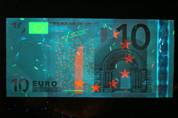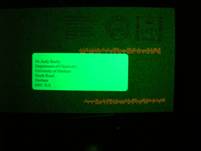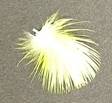Luminescence

6. Luminescence
Luminescence – also referred to as phosphorescence and fluorescence, is the term used to describe the emission of light by a sample following excitation of some kind, most often as the result of the absorption of light, although other stimuli such as chemical reactions, physical agitation and the passage of a current can also lead to the emission of light in certain systems. Luminescence is all around us – from the blue whiteners used in laundry products, to the security markers used in our currency: everything glows. It is also one of the easiest phenomena to demonstrate and never fails to entertain and enthuse!
In the Suitcase we supply a UV-LED light source, producing light at 365nm. The light form this lamp can excite a whole host of samples, producing a wealth of visible emission from lots of every day – and not so everyday – items.

Things that glow….
A Euro (UK currency also has luminescent markers, but they’re not as pretty as a Euro…)

Stamps and envelopes: those orange dots that are printed on the post are added to allow machine reading and processing of the post. The stamps are coded with a luminescent tag too!


Lots of animals glow under UV light. For example a budgerigar feather taken from the cheeks or head of the bird glows nicely! On the left is a feather taken under normal room light, on the right is the same under UV. Why do they do that?

A. Beeby, 04/09/08
